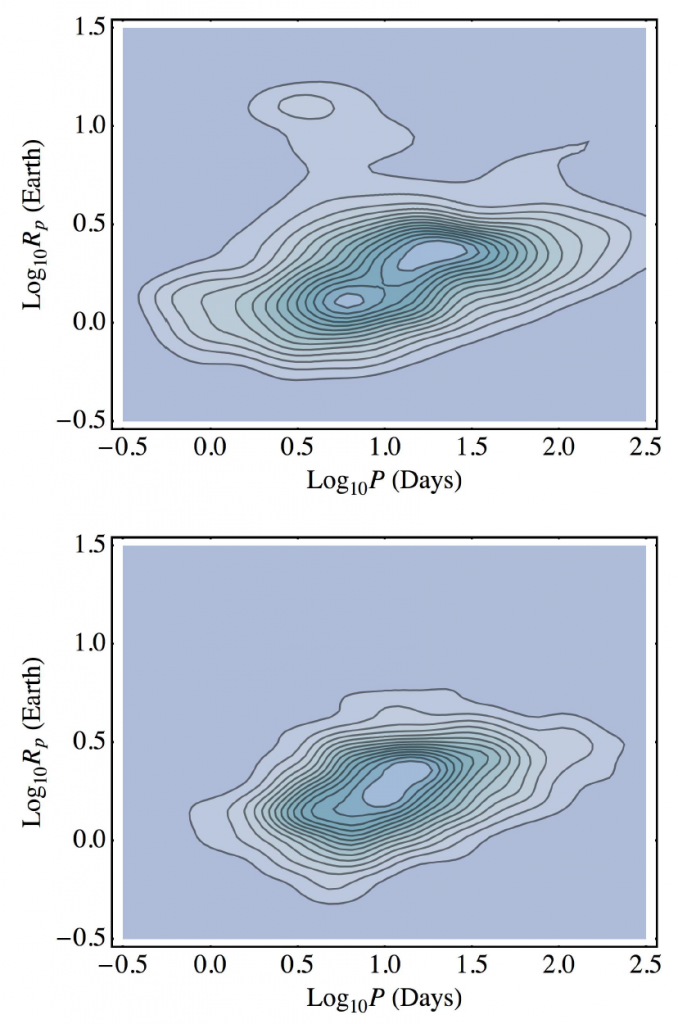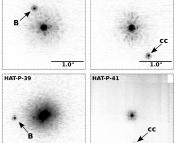Title: A population of planetary systems characterized by short-period, Earth-sized planets
Authors: Jason H. Steffen and Jeffrey L. Coughlin
First Author’s Institution: University of Nevada, Las Vegas
Status: Published in the Proceedings of the National Academy of Sciences (PNAS)
The Kepler space telescope has discovered just over 2500 exoplanets to date, which is more than 70% of all exoplanets found so far. It has discovered planets and systems vastly different from what we see in our own solar system, such as Super Earths and tightly packed planetary systems. While both of these are quite easy to visually recognize in the data, other types of systems might not be so apparently obvious. The authors of this paper claim to discover one such hidden planetary architecture: a population of systems whose main signature is having a short-period (~1 day), Earth-sized planet.
Single Transit Systems
There are multiple types of planetary systems that Kepler has observed that can have a single observed transiting planet. Hot Jupiter systems are one such class, which is characterized by a massive, short-period planet which rarely has other planets observed in the system. This is caused by its unique, destructive formation mechanism, where the planet migrates inward through the protoplanetary disk or is scattered inward by near collisions with other planets, which disrupts the inner planetary system. Another type of single transiting system is merely a result of observational bias in the transit system. If a system with multiple planets is tilted relative to Earth, or if the planets are not perfectly aligned in a flat plane, sometimes only one planet will be observed to transit.
The authors test the observed orbital period-planet radius distribution of planets to see if the number of single transiting systems can be explained simply by the observational bias of tilted or misaligned planetary systems. They do this by attempting to reproduce the distribution of single transiting systems by randomly drawing one planet from the multiplanet systems. If the randomly drawn planets match the distribution of single transiting systems, then it’s likely that the single transiting systems are similar to the multiplanet systems, but with just one of the planets transiting. However, any regions in the period-radius diagram for single transiting planets that do not match the random draws from multiplanet systems could indicate the existence of a different class of planetary system altogether.

Figure 1: The period-radius distribution for single transiting systems (top) and multiplanet systems (bottom). Taking the difference of these two plots effectively highlights regions of period-radius space where the single transiting systems cannot be reproduced by randomly sampling a single planet from the multiplanet systems.
This experiment produced four regions where the period-radius distribution of planets randomly drawn from a multiplanet system did not match the distribution of single transiting systems. One of these four regions is the Hot Jupiters, and two other regions can be explained away by biases and inherent deficiencies in this technique. However, one region cannot be explained away: short-period, Earth-sized planets, dubbed “Hot Earths”.
Origins of Hot Earth candidates
The authors identify four potential origins of the Hot Earth candidates in the Kepler data.
- Statistical false positives: the candidates are simply caused by fluctuations in the measured starlight that look like transits. Out of 146 Hot Earth candidates, further analysis shows only two that are likely to be statistical false positives.
- Astrophysical false positives: the candidates are actually caused by an unresolved eclipsing binary in the background of the pixel. Using knowledge of the binary rate and the density of stars in the region near the star, they expect only 3% of the 144 Hot Earth candidates to be an astrophysical false positive.
- Systems with undetected distant planets: the candidates are just the innermost planet of multiplanet systems where the outer planets aren’t detected. For each Hot Earth candidate, the authors simulated outer planets that are similar in nature to the multiplanet systems that also have a Hot Earth. From their simulations, they found that an average of 77 Hot Earths could be explained by this, with an upper limit of 112.
- Isolated Hot Earths: the candidates are truly alone, or the outer planets are significantly farther away or more inclined than typical multiplanet systems. By process of elimination, there are about 24 Hot Earths fitting this category, or about 17% of the total sample of Hot Earth candidates.
Isolated Hot Earth Formation
If there truly is an excess of Hot Earths, there are a few potential causes. They could be the evaporated cores of Hot Jupiters. If true, this would nearly double the Hot Jupiter rate. Conversely, two other scenarios have these planets starting out at approximately their current mass, but farther out in the system. In one scenario, the planet migrates inward during planet formation until it hits the inner edge of the protoplanetary disk, where it stops. In the other scenario, dynamical and gravitational interactions between planets can drive the innermost planet very close to the star.
If these Hot Earth systems are real, this adds another complication (and another test) for planetary formation models, which now need to also explain this new type of planetary architecture.





Trackbacks/Pingbacks